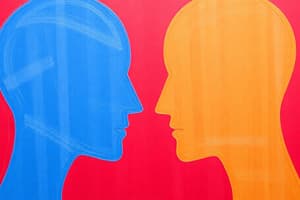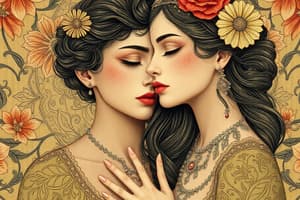Podcast
Questions and Answers
According to Rhonda Unger, what is the primary distinction between the terms 'sex' and 'gender'?
According to Rhonda Unger, what is the primary distinction between the terms 'sex' and 'gender'?
- 'Sex' encompasses both biological and cultural aspects, while 'gender' strictly refers to biological factors.
- 'Sex' is a broader term that includes gender identity, while 'gender' is limited to physical characteristics.
- 'Sex' refers to biological factors, while 'gender' refers to the nonbiological, culturally constructed aspects. (correct)
- There is no significant difference; the terms can be used interchangeably.
Which of the following best represents the challenge in determining whether differences between men and women stem from biological or other factors?
Which of the following best represents the challenge in determining whether differences between men and women stem from biological or other factors?
- Biological factors are easily identifiable through genetic testing, making it straightforward to differentiate from social factors.
- Social factors are constant across different cultures, making it easy to isolate biological influences.
- Hormonal influences, such as testosterone, are solely determined by genetics and cannot be influenced by social behaviors.
- The interplay between biological and social factors is complex, as behaviors can influence hormonal levels, blurring the lines between the two. (correct)
Which statement accurately reflects the perspective on biological sex categories presented?
Which statement accurately reflects the perspective on biological sex categories presented?
- While biological sex exists on a spectrum, cultures do not recognize more than two sexes.
- Biological sex categories are universally fixed and binary across all cultures.
- The recognition of more than two sexes is a modern phenomenon, not historically recognized.
- Some cultures recognize more than two sexes and genders, challenging the notion of strict binary categories. (correct)
What does Janet Spence's multifactorial theory of gender identity emphasize?
What does Janet Spence's multifactorial theory of gender identity emphasize?
What is a primary critique of Janet Spence's theory of gender identity?
What is a primary critique of Janet Spence's theory of gender identity?
What approach do Kay Deaux and Abigail Stewart advocate for when viewing gender?
What approach do Kay Deaux and Abigail Stewart advocate for when viewing gender?
What practices are suggested to develop a more intersectional approach in psychological research?
What practices are suggested to develop a more intersectional approach in psychological research?
What is the effect of adopting the suggested practices in psychological research?
What is the effect of adopting the suggested practices in psychological research?
In what ways do sex and gender act as schemas?
In what ways do sex and gender act as schemas?
In what areas of life do sex and gender NOT play a role?
In what areas of life do sex and gender NOT play a role?
Why might individuals sometimes fail to notice the influence of gender on everyday interactions and behaviors?
Why might individuals sometimes fail to notice the influence of gender on everyday interactions and behaviors?
When should gender be made more visible as a way of challenging norms and beliefs?
When should gender be made more visible as a way of challenging norms and beliefs?
Which groups are more likely to recognize the influence of gender in their lives?
Which groups are more likely to recognize the influence of gender in their lives?
What is the definition of 'privilege'?
What is the definition of 'privilege'?
What role do dominant groups play within hierarchical social structures?
What role do dominant groups play within hierarchical social structures?
How are dominant groups represented compared to others?
How are dominant groups represented compared to others?
What is the distinction between matriarchal and matrilineal societies?
What is the distinction between matriarchal and matrilineal societies?
What is the impact of normalized gender perceptions on societal awareness?
What is the impact of normalized gender perceptions on societal awareness?
How do dominant groups perpetuate disparity?
How do dominant groups perpetuate disparity?
What is the result of gendered socialization?
What is the result of gendered socialization?
Flashcards
Sex (Rhonda Unger's definition)
Sex (Rhonda Unger's definition)
Biological factors such as sex chromosomes and sexual anatomy.
Gender (Rhonda Unger's definition)
Gender (Rhonda Unger's definition)
Nonbiological, culturally constructed aspects of being male or female.
Two-Spirit People
Two-Spirit People
People who adopt elements of both female and male gender roles in some Native American cultures.
Hijras
Hijras
Signup and view all the flashcards
Androgyny
Androgyny
Signup and view all the flashcards
Multifactorial Theory of Gender Identity (Janet Spence)
Multifactorial Theory of Gender Identity (Janet Spence)
Signup and view all the flashcards
Deaux and Stewart's View of Gender
Deaux and Stewart's View of Gender
Signup and view all the flashcards
Intersectional Approach in Psychology
Intersectional Approach in Psychology
Signup and view all the flashcards
Sex and Gender Schemas
Sex and Gender Schemas
Signup and view all the flashcards
Privilege
Privilege
Signup and view all the flashcards
Matrilineal Societies
Matrilineal Societies
Signup and view all the flashcards
Hierarchical Social Structures
Hierarchical Social Structures
Signup and view all the flashcards
Study Notes
- Rhonda Unger argued the word "sex" is overused, as it refers to sex chromosomes and sexual anatomy, both biological.
- Unger suggested reserving the term "sex" for biological aspects and using "gender" for nonbiological, culturally constructed aspects.
- Differences between men and women are labeled as sex differences, even if they do not always stem from biological factors.
- It is difficult to determine which differences stem from biological factors versus other factors.
- Performing male behaviors can increase testosterone in women, while performing female behaviors can decrease testosterone in men.
- Biological sex categories are not fixed.
- Some cultures recognize more than two sexes and genders.
- Two-spirit people (Native American) adopt elements of both female and male gender roles.
- Hijras (India) live as neither men nor women and are viewed as sacred.
- Some researchers argue androgyny is good for health; high levels of male-typed traits and low levels of female-type traits was best in boys.
- According to Janet Spence's multifactorial theory of gender identity, a wide variety of uncorrelated attributes shape gender identity and vary person to person.
- Knowing someone identifies as a man does not mean we know that they like sports.
- Most people develop a sense of belongingness to their assigned sex early in life and maintain this identity throughout their life.
- Spence's theory fails to account for the full spectrum of nonbinary and fluid gender identities.
- Kay Deaux and Abigail Stewart view gender as a set of overlapping identities that are negotiated dynamically and shaped by norms and social contexts.
- Psychologists should develop a more intersectional approach.
- Researchers should ask who is included in the social categories of the people they study.
- Researchers should consider the role of structural inequalities in shaping participant's experiences
- Researchers should look for commonalities in participant experiences despite differences in identities.
- These practices prompt researchers to view categories such as race and gender with broader contexts of privilege and discrimination, rather than viewing them as internal features of individuals.
- Sex and gender are powerful schemas (or mental frameworks) through which most people process their social worlds.
- Sex and gender play many roles in our lives: appearance, dress, occupation, education, political outcomes, physical outcomes, and interpretations of basic constructs such as foods and colors.
- The influence of gender on our everyday interactions and behaviors is so routine and normalized that we sometimes fail to notice it.
- While de-emphasizing gender can be positive, it should be more visible in situations as a way of challenging norms and beliefs that reinforce gender inequality.
- Less privileged groups more readily recognize the influence of gender in their lives than privileged groups.
- Privilege is an automatic and unearned advantage and comes with an absence of certain stressful and unpleasant experiences, so it can be difficult to detect.
- Some form of hierarchal social structure exists in all human societies, though the specific forms that hierarchies take vary from culture to culture.
- Dominant groups have more access to opportunities and resources and shape the norms and laws that govern society, therefore shape the outcomes of the subordinate groups.
- Dominant groups enjoy more representation and visibility.
- There is a lack of evidence for true matriarchal societies.
- Matrilineal societies exist, in which family relationships and ancestry are traced through the mother's line.
Studying That Suits You
Use AI to generate personalized quizzes and flashcards to suit your learning preferences.




